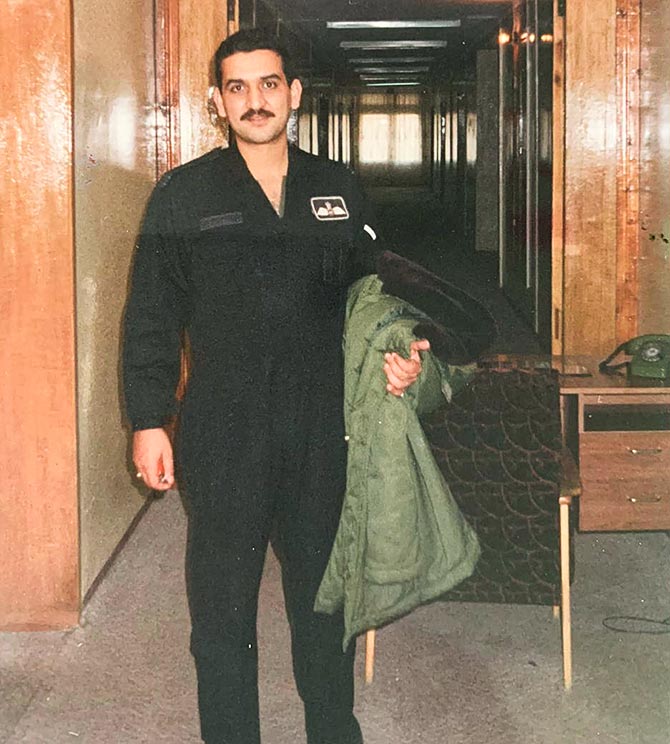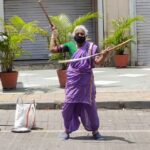Twenty one years ago, the Indian Army and Indian Air Force fought a bloody and bitter war to evict Pakistani intruders from the icy heights in Kargil.
Air Commodore Nitin Sathe (retd) salutes the lesser known heroes of the Kargil War.
Wing Commander Shakul Tyagi (retd)
IMAGE: Wing Commander Shakul Tyagi during the Kargil War in 1999. All Photographs: Kind courtesy Wing Commander Shakul Tyagi
A friend from Army Aviation, long retired but a keen helicopter buff, narrated this story when I told him I was writing about the helicopter operations in Kargil.
“There were marks in the snow as I recceed the areas we had withdrawn from during the winter almost a year before the actual fighting broke out. I had gone there with three aircraft for my annual training in which we practised ‘shoots’ with the artillery,” the friend recalled.
“I sensed that things were not okay since the artillery guns were not available for practice for live firing at the ranges. There had been sporadic firing from across which was getting more and more accurate; and our artillery was being readied for counter bombardment,” he remembered.
“It appeared that the Pakistani gunners were getting accurate inputs on the ‘fall of shot’ and that could happen only if they were visual with the Indian side.”
On a special reconnaissance flight along the Drass-Kargil axis, the pilots had seen fresh footprints in the snow at the posts vacated by our soldiers for the winter.
“Putting two and two together,” the friend said, “it was evident that the Pakistanis had infiltrated onto our side and were well dug in. I submitted a written report of my findings and went back to base.”
“I guess we took it too casually; if we had acted then, Kargil wouldn’t have happened.”
Helicopters always have been a very important part of any mission/operation, offensive or otherwise. And so they were in the Kargil operations.
By the 10/11 of May, 1999, around 8 helicopters of the Mi-17 class had been inducted into Srinagar.
A large number of troops, ammunition and stores were being inducted and the para-commandos were being given refresher training to slither from the helicopters.
All the aircrews had been called to discuss options at a meeting held in the underground ops centre at Srinagar which continued well into the night.
Targets were at extreme heights, accuracy as well as aircraft limitations were issues and discussions heated up as the night wore on.
“Air Vice Marshal Narayan Menon (then Air Officer Commanding, J&K) and Air Marshal Vinod Patney (then Air Officer Commanding in Chief, Western Air Command) were also present along with a lieutenant general from the army,” remembers Wing Commander Shakul Tyagi who was present at Srinagar through the Kargil operations and through whose eyes I describe this story.
“For the first time, we saw that the fighter boys speak about the high efficacy and efficiency of the helicopters in an armed role in this scenario,” he remembers.
“It was good to hear that the importance of helicopters as a weapon platform was being recognised by the fighter boys,” says the Indian Air Force veteran.
“The MiG-27 had severe problems of weapon release at high altitudes and it was felt that the engine may fail due to the high thrust and blast of the weapons at that altitude.”
“Finally, the big bosses took the decision. The fighters were to give supporting fire and help in keeping the enemy heads down; and as soon as they did their bit, the helicopters were to spring a surprise by carrying out rocket attacks at the posts on the hill tops.”
“The question of shoulder fired missiles came up during these discussions. All the helicopters were not equipped with flare firing equipment to thwart the shoulder fired Stingers which the enemy was known to have in plenty.”
“A via media was worked out, each attacking formation of four helicopters was to have at least two fitted with the equipment and the helicopters were to tuck in close to each other till they went on to fire at the target. This was to prove fatal just a few days later.”
“When we discussed this amongst ourselves, we decided that we would fire our rockets and dive into the valley and get away, making it difficult for the missiles to be fired.”
“Also, we decided to do the morning missions from the east with the sun behind us so that we could be hidden in the glare.”
“The evening missions were, of course to be done from the west. That was the best way to keep safe.”
“If the fighters were raw at firing at those altitudes, we hadn’t had any exposure at all; and therefore, we were at a huge disadvantage.”
“But helicopter pilots are innovative and quick to adapt to new situations/tactics and we did so and put everyone’s doubts about us to rest.”
“A total of 5 missions by four aircraft each were flown by us; the first one being on the morning of the 26th May.”
“On the first day, things went as planned, but for the aircraft with CMDS (Counter Measure Dispensing System) which had a technical snag. We had an army observer in the lead aircraft who tried to identify targets for us.”
“On the way back we landed at the helipad at Mattayan to pick up casualties. Here, we also got debriefed from the artillery boys who could observe the firing from where they were deployed.”
“We did two successful missions that day — the same day that we lost two fighters and got the news of Ahuja’s killing.”
“In fact, both the fighters went down within 45 minutes of each other and we were told to hastily prepare for Combat Search and Rescue, something that we had little practised for, but had read of the daring missions flown by the USAF (United States Air Force) to pick up their downed pilots from behind enemy lines.”
“Despite the fact that this was to be the most dangerous of missions with every chance of not coming back, crew volunteered for the mission with Wing Commander A K Sinha, the overall task force commander, leading from the front.”
“They were loaded with 192 rockets, bulletproof jackets, emergency stores and personal weapons to go within an hour of being told to get ready.”
“With heavy hearts we saw the aircraft taking off that morning, we knew there was a good chance of casualties. As they took off, the ATC (air traffic control) called up and radioed them to return. News had been received from across the border that Ahuja was dead and Nachi (Flight Lieutenant K Nachiketa) was in their hands.”
“Similar missions were flown on the 27th, the targets being Tololing top and a place called Helmet Feature. Both these were successful and we were gaining in both, confidence and marksmanship.”
“We also flew one big 130 mm Medium Gun (7,700 kgs) broken up in three parts and slung under the aircraft from Kupwara to ‘Balbir top’ where it was urgently required.”
“These Russian guns have a 30 plus kilometre range and proved to be very accurate weapons during this conflict.”
“Besides this, 6 light guns were dropped in the Gurez valley to augment firepower there on the same day.”
“Shifting from an offensive role to a load carrying role is not easy. Ask the technical guys and they will tell you what a backbreaking effort it is.”
“Pylons and pods have to be removed, rollers and load carrying boards need to be fitted, the rear doors need to be removed for drop sorties plus some electrical and hydraulic connections need change.”
“Young Flight Lieutenant (Benoy Shanker) Jamuar, who headed the technical team, needs a special mention here. He used to get up at 0230 at night and go to the aircraft. Eating all his meals on the tarmac, he preferred to be with his men and provide them the motivation to work round the clock. More often than not, he got just a few hours in his bed for days on end.”
“We flew these missions seeing enemy shells landing around us, it was scary, quite uncomfortable but unforgettable!”
“On the 27th evening Suadron Leader Rajiv Pundir arrived from base in an An-32 as additional crew. He got along a cake for Flight Lieutenant Subramaniam Muhilan from his wife Bina at Sarsawa.”
“His birthday was coming up in the next two days and celebrations were in the offing. The cake was kept on the table near the bed, Muhilan and I shared a room,” remembers the veteran.
“The birthday bash was to be after the mission on the 28th.”
“The morning mission on the 28th was with Chinky sir (now retired Air Commodore Anil Kumar Sinha), in the lead and Pundir and Muhilan as No 3.”
“While the aircraft started up in the morning, there was a lot of panic on the tarmac with two helicopters going unserviceable.”
“Crew hopped from one helicopter to another and finally the mission got airborne. There had been an inordinate delay which was going to prove costly.”
“Meanwhile, the fighters got airborne as planned and did their jobs. They were returning to base, low on fuel, when the helicopters reached to fire their rockets.”
“They flew tucked in close to each other so as to get cover from the missile threat. Aircraft dispensed their flares as they descended into the missile envelope of the enemy, closing in to the target.”
“But when it was time to fire, the helicopters had to maintain lateral separation from each other so that they did not fly into each other’s wake/trajectory.”
“This was the opportunity that the enemy with the shoulder fired missiles on ground were waiting for.”
“A missile was fired, and for once, the Pakistanis scored a direct hit. The aircraft flown by Pundir and Muhilan went spiralling down and crashed into a plume of dust and smoke. There was no hope for the crew.”
“It was a sad ending to a series of successes. But then, in war, one has to bear losses too and we did take it in our stride.”
“The helicopter operations came to a stop till we got our CMDS (Counter Measures Dispensing System) aircraft on line.”
“By then, the army had already claimed back our territory losing almost 500+ lives and more than double that number injured.”
IMAGE: A letter from then Air Commodore R M Sridharan to then Wing Commander Shakul Tyagi.
Operation Safed Sagar, as it was aptly named, came to an end by mid July, and the guns officially fell silent on July 26th, with then prime minister Atal Bihari Vajpayee announcing the complete eviction of the Pakistani intruders.
“The untouched cake kept on Muhilan’s bedside kept reminding me of my room-mate; a stark reminder of the cruelty of war.”
Feature Presentation: Rajesh Alva/KhabriBaba.com




